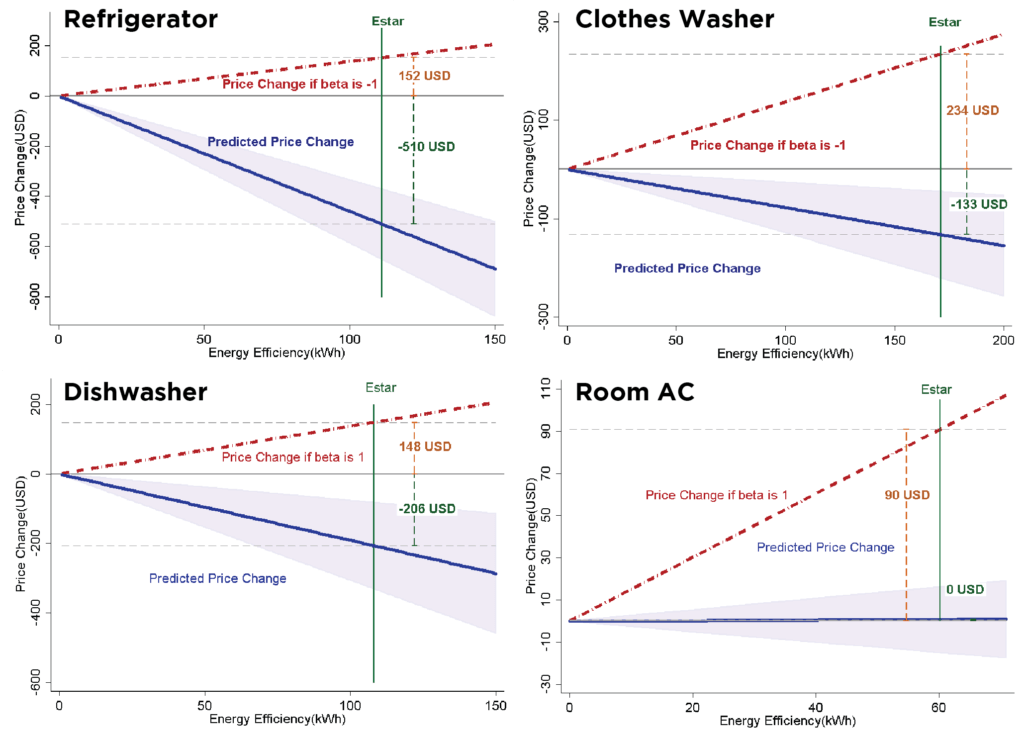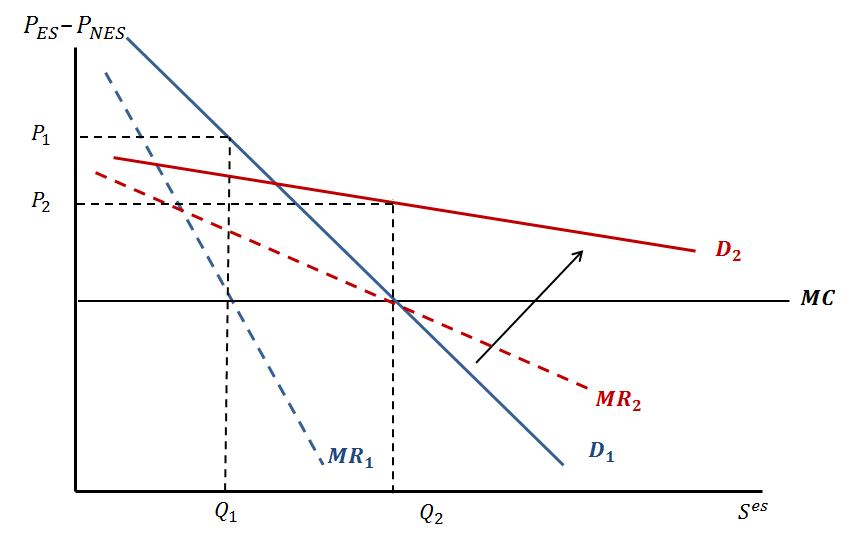The WEER Student Blog Series features student reviews of presentations from UHERO’s Workshop on Energy and Environmental Policy
Abstract: The notion of an energy efficiency gap posits that people under-invest in energy efficiency, since the present value of savings from more energy-efficient appliances, cars and other energy-consuming durable goods tends to far exceed their additional up-front cost. A considerable literature demonstrates this gap, and it has been a key factor underpinning energy-efficiency regulations. Critics contend that evidence backing an energy efficiency gap is mainly cross-sectional, and may be confounded by unobserved attributes of durable goods that are associated with energy efficiency. Taking an approach somewhat similar to recent work by Alcott and Wozny (2014), we use data on prices and quantities for a near population of sales of individual models of refrigerators, clothes washers, dishwashers and room air conditioners to revisit the question of whether an energy efficiency gap exists and how large it may be. Specifically, we consider whether changes in interest rates and electricity prices, which can significantly influence the present value of more efficient versus less efficient appliances, affect changes in sales and relative prices of more versus less efficient appliances. Model fixed effects control for unobserved attributes. We find that lower interest rates and higher electricity prices have driven sharp increases in sales of more energy efficient appliances, but that these changes tend to drive prices for more energy efficient appliances down, not up, with the exception of room air conditioners. The results suggest persistence of a very large energy efficiency gap. The results also suggest that economies of scale and imperfect competition likely complicate cost-benefit analysis of energy standards and other efficiency-related policies.
– Hyun-Gyu Kim and Michael Roberts, University of Hawaii Department of Economics and UHERO
Review by Arlan Brucal
On February 12, 2016 the Department of Energy (DOE) proposed another energy efficiency standard (expressed in minimum lumen output per watt) for General Service Lamp (GSL), better known as light bulbs. Based on DOE’s calculation, the proposed energy conservation standards for GSLs would save households up to 16 percent of energy use relative to the no-new-standards case. This translates to total consumer savings ranging from $4.4 billion to $9.1 billion, 1 compared to just $221 million estimated cost to manufacturers. This rule is expected to be issued by January 1, 2017.
If DOE’s information on cost savings is accurate, wouldn’t it be in consumers’ best interest to invest in more energy efficient lightbulbs (e.g. light emitting diode or LEDs)? Then how come incandescent halogens 2 still represent roughly 50 percent of recent new bulb shipments to U.S. retailers? 3 Does this mean that consumers are not making the most economically rational decision? Do we have sufficient evidence to say that there exist market imperfections to merit the imposition of more stringent energy efficiency standards? Do consumers need government intervention to help them achieve greater cost savings (and significant reductions in carbon emissions as well)? And if they do, is imposing standards the most efficient way to achieve that or it just more politically feasible? Does the so-called energy efficiency gap exist and how big is it?
To help revisit the issue on energy efficiency gap – the tendency of consumers to discount future energy savings against upfront cost, Hyun-Gyu Kim, a PhD candidate at the Department of Economics at UH Manoa, presents his work with Michael Roberts that measures the value of energy efficiency in major US appliances and verifies if the energy efficiency gap is indeed large and significant. Using the most recent data on US major appliances and an up-to-date empirical strategy, they find that the price of energy efficient products relative to non-energy efficient products was surprisingly decreasing.
The figure below illustrates the predicted change in the price of Energy Star-certified appliances relative to non-certified appliances using the estimated coefficients (the blue line) and the coefficient signifying consumers’ equal valuation between upfront cost and future energy savings (red dashed line). The green vertical line indicates the Energy-Star certification threshold in terms of annual electricity use (kWh). If consumers equally value the extra cost of buying Energy Star refrigerators and the present value of future energy savings, then the price of refrigerators should have increased by $152 (see top left panel). However, their estimates imply that the relative price may have actually decreased by $510. The same findings apply to clothes washers (top right panel) and dishwashers (bottom left panel), indicating a decline in the relative price of Energy Star-certified to non-certified appliances by $139 and $206, respectively. Room AC (bottom right panel) illustrates a different trend, indicating consumers’ undervaluation of future energy cost (i.e. the relative price should have increased by $90 as opposed to the observed price that remained relatively constant.

Hyun-Gyu explained that this seemingly unusual relationship between the extra upfront cost and the present value of operating cost (PVOC) is likely driven by imperfections in the market. Manufacturers may be facing declining cost with respect to producing more energy-efficient products due to technological advance (e.g. increased automation) or competitive sourcing of components. 4 If this is true, any shift in market demand for more energy-efficient products would translate into a drop in the price of these products relative to non-efficient ones.
Consumers may also exhibit more elastic demand due to continuous increases in electricity prices, and thus in PVOC. As PVOC increases, more consumers start looking at more energy efficient appliances. This makes demand shift and become flatter, making the relative price to fall (See figure below).

Note: The figure illustrates the changes in price and quantity when the demand for Energy Star (ES)-certified appliance becomes more elastic (D1 to D2). The y-axis of the graph indicates the price difference between ES and non-ES certified appliances, and the x-axis shows the sales of ES certified appliances. The black solid line denotes the (constant) marginal cost of an additional ES certified appliance in the market.
While the study did not explicitly answer the question of whether the energy efficiency gap is small or not, it puts more qualifications on the issue by demonstrating that the dynamics behind the energy efficiency gap is more complex than most of us think. Certainly, the market on energy-using durable goods is characterized by a number of market failures, including, among others, information asymmetry, externalities and imperfect competition. Whether consumers indeed undervalue future energy savings or just do not have that many options in the market to choose from or it is a combination both demand and supply factors, remains an empirical question.
BLOG POSTS ARE PRELIMINARY MATERIALS CIRCULATED TO STIMULATE DISCUSSION AND CRITICAL COMMENT. THE VIEWS EXPRESSED ARE THOSE OF THE INDIVIDUAL AUTHORS. WHILE BLOG POSTS BENEFIT FROM ACTIVE UHERO DISCUSSION, THEY HAVE NOT UNDERGONE FORMAL ACADEMIC PEER REVIEW.
[1] The estimates are based on Net Present Value at 7-percent and 3-percent discount rate, respectively.
[2] Incandescent halogens are the tweaked incandescent bulbs introduced to meet the first phase of the standards that went into effect between 2012 and 2014. These bulbs are less energy efficient than LEDs.
[3] Extracted from http://switchboard.nrdc.org/blogs/nhorowitz/proposed_light_bulb_energy_eff.html
[4] Ellis, M., Jollands, N., Harrington, L., & Meier, A. (2007, June). Do energy efficient appliances cost more. In Proceedings of the ECEEE 2007 Conference, Summer Study, Panel (Vol. 6).